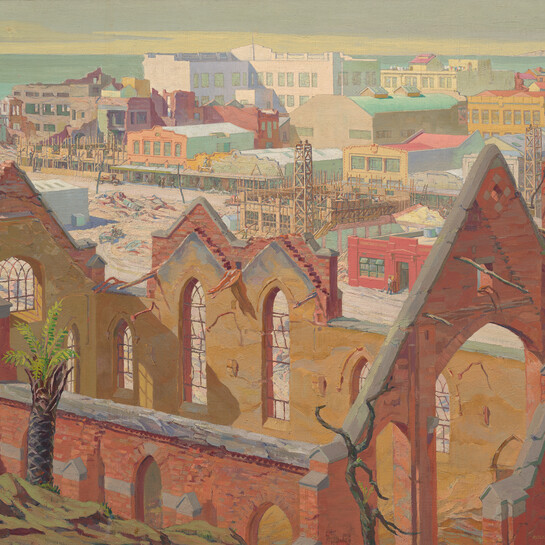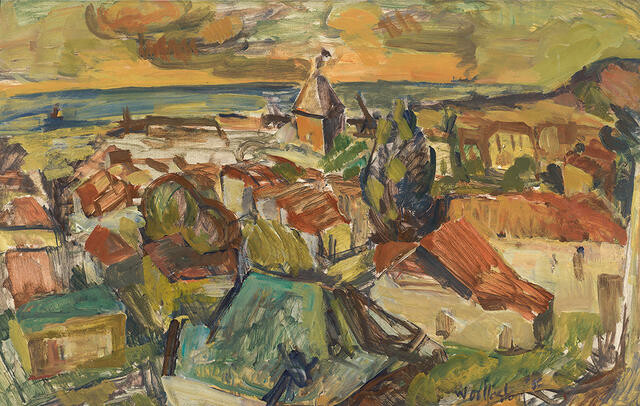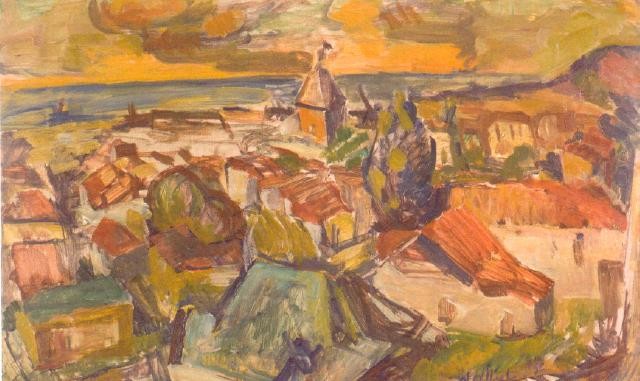Toss Woollaston
Aotearoa New Zealand, b.1910, d.1998
Landscape with Tower, Greymouth
- 1952
- Oil on ivory board
- Purchased by the Friends of Christchurch Art Gallery, 2007
- 669 x 1004mm
- 2007/001
- View on google maps
Location: Monica Richards Gallery
Tags: buildings (structures), churches (buildings), houses, landscapes (representations), religious buildings, seas, towers (single built works), urban landscapes
Urban landscape was uncommon subject-matter for Toss Woollaston, who became best known for his atmospheric natural landscapes, which were characteristically energetic fusions of hills, water and sky. The exception was a series of works created following his arrival in Māwhera Greymouth, painted from his own front veranda, looking out across the town. Woollaston had previously been living with his family in Mapua near Whakatū Nelson, and moved to Greymouth in December 1949 through an opportunity to support his family as a ‘Rawleigh’s man’, a door-to-door travelling salesman of ointments and health products. Writing to his wife, Edith, on the day he arrived, he described Greymouth as “a crowd of grey churches and buildings at all angles, with high green and bushy hills just as sharp and angular rising behind – not mine yet”. He was joined by Edith and their family a few months after arriving. By 1952 when he sent this work off to the 1952 Group exhibition, he had evidently overcome his earlier expressed reservations.
(From Here on the Ground, 18 May – 17 November 2024)
Exhibition History
Te Wheke: Pathways Across Oceania, 30 May 2020 – 3 July 2022
Toss Woollaston arrived in Māwhera / Greymouth in 1949. He wrote of the town, “Greymouth… a crowd of grey churches and buildings at all angles, with high green and bushy hills just as sharp and angular rising behind – not mine yet.”He purchased a house on the hill above the town, and painted this work for the 1952 Group exhibition in Christchurch – a view from the front verandah looking out to the Tasman Sea.
Brought to Light, September 2009
By the 1950s Toss Woollaston had established his reputation in New Zealand as a leading modernist painter. He worked quickly and spontaneously in a gestural manner that infused his works with much immediacy and energy As a pioneering modernist working in mid-twentieth-century New Zealand, Woollaston faced many challenges. It was with difficulty that he managed to continue painting while supporting his family, and it was not until the late 1960s that he was able to commit himself fully to his art. He moved to Greymouth in 1949 and the West Coast landscape is the subject of some of his most vigorous artistic treatments. Portraiture was also an important element in Woollaston’s output and something that he pursued throughout his career. Of his approach to portrait painting he commented: 'I have to observe (the subject), sometimes for quite a long time, till I find their most natural attitudes and movements. I do not copy their actual physical movements...but I have a rich means of suggesting them - the lean and tilt of the different planes and volumes in contrasting directions - what I understood by Hans Hofmann’s term movement and tension on the picture planes...'





